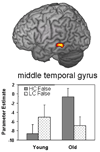Age-related differences in brain activity during true and false memory retrieval
- PMID: 18303982
- PMCID: PMC3114875
- DOI: 10.1162/jocn.2008.20096
Age-related differences in brain activity during true and false memory retrieval
Abstract
Compared to young adults, older adults show not only a reduction in true memories but also an increase in false memories. We investigated the neural bases of these age effects using functional magnetic resonance imaging and a false memory task that resembles the Deese-Roediger-McDermott (DRM) paradigm. Young and older participants were scanned during a word recognition task that included studied words and new words that were strongly associated with studied words (critical lures). During correct recognition of studied words (true memory), older adults showed weaker activity than young adults in the hippocampus but stronger activity than young adults in the retrosplenial cortex. The hippocampal reduction is consistent with age-related deficits in recollection, whereas the retrosplenial increase suggests compensatory recruitment of alternative recollection-related regions. During incorrect recognition of critical lures (false memory), older adults displayed stronger activity than young adults in the left lateral temporal cortex, a region involved in semantic processing and semantic gist. Taken together, the results suggest that older adults' deficits in true memories reflect a decline in recollection processes mediated by the hippocampus, whereas their increased tendency to have false memories reflects their reliance on semantic gist mediated by the lateral temporal cortex.
Figures




References
-
- Aggleton JP, Brown MW. Episodic memory, amnesia, and the hippocampal–anterior thalamic axis. Behavioral and Brain Sciences. 1999;22:425–444. discussion 444–489. - PubMed
-
- Balota DA, Cortese MJ, Duchek JM, Adams D, Roediger HL, McDermott KB, et al. Veridical and false memories in healthy older adults and in dementia of the Alzheimer’s type. Cognitive Neuropsychology. 1999;16:361–384.
-
- Bastin C, Van der Linden M. The contribution of recollection and familiarity to recognition memory: A study of the effects of test format and aging. Neuropsychology. 2003;17:14–24. - PubMed
-
- Battig WF, Montague WE. Category norms for verbal items in 56 categories: A replication and extension of the Connecticut norms. Journal of Experimental Psychology. 1969;80:1–46.
-
- Bayen UJ, Phelps MP, Spaniol J. Age-related differences in the use of contextual information in recognition memory: A global matching approach. Journal of Gerontology: Series B, Psychological Sciences and Social Sciences. 2000;55:P131–P141. - PubMed
Publication types
MeSH terms
Substances
Grants and funding
LinkOut - more resources
Full Text Sources
Other Literature Sources
Medical

